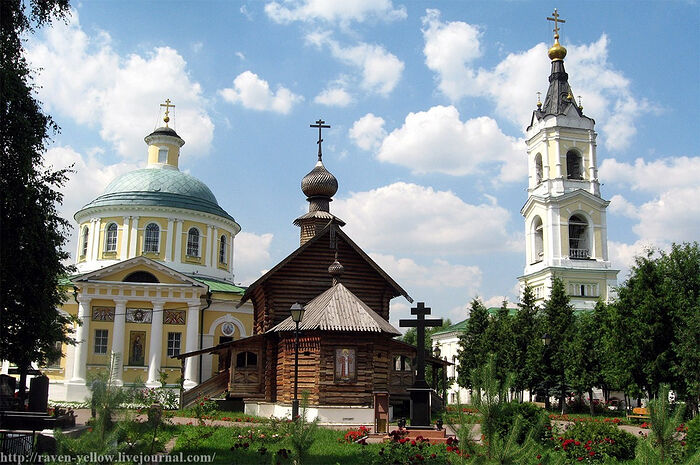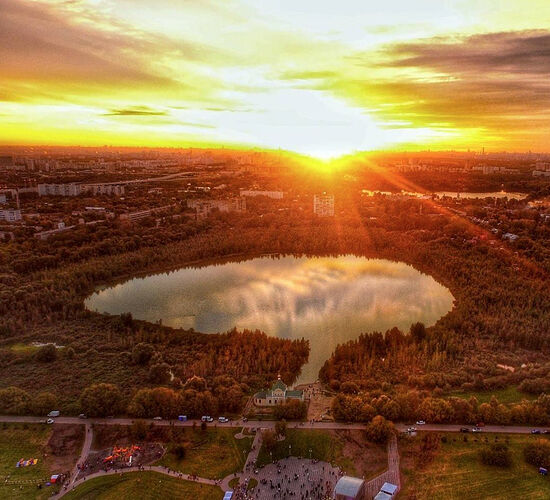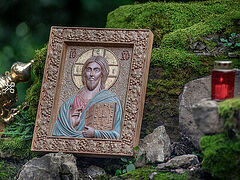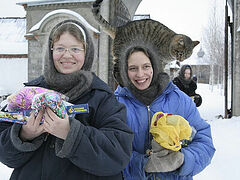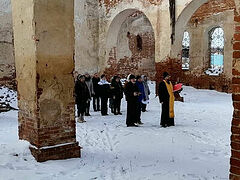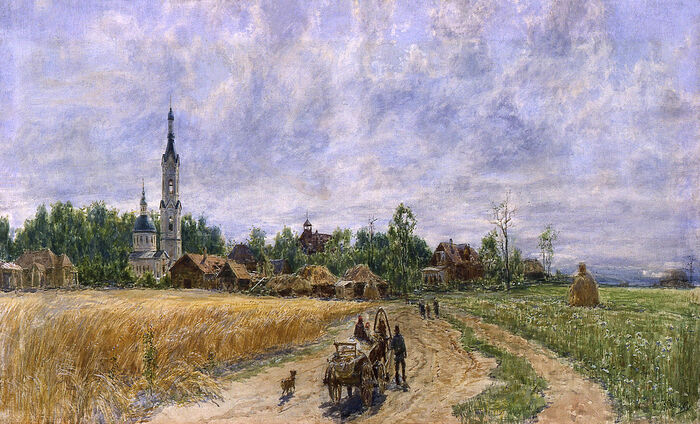 Landscape. Kosino. 1887. Artist: Konstantin Apollonovich Savitsky
Landscape. Kosino. 1887. Artist: Konstantin Apollonovich Savitsky
Those who grew up in the USSR remember obligatory school lessons on September 1, the topics for which were set by the District Department of Public Education (DDPE) or the City Department of Public Education (CDPE) with their lack of imagination. Thus, on September 1 of some forgotten year, in my Moscow school no. 861 of the Chertanovo district, the teacher of our eighth C grade—the wonderful physical education teacher Alexander Nikolaevich—was looking extremely disapprovingly at a form with the topic of the lesson: “Moscow Is the Capital of Our Motherland.”
Having looked around our class and assessed its intellectual power, he assumed that “everyone is well informed,” after which we proceeded to discuss more pressing topics.
For me, Moscow was then a dear, cozy, warm and beloved city, where the past and the present united with Zamoskvorechye,1 which smelled of chocolate from the Rot Front chocolate factory (the former Trading House of the Lenov merchants); the streets that my father’s brother, our legendary uncle Mark who lived in Presnya2 called only in the old Muscovite manner: (“This is Nikolskaya Street, not Street of the 25th of October!”); and my father’s Khamovniki barracks (former barracks of the First Regiment of Hussars of Sumy), around which he as a student of the Military-Conducting Department at the Moscow Conservatoire played football with his fellow students. There is also the St. Nicholas Church in Khamovniki, which was never closed in the Soviet era.
True, at that time I didn’t know that this church housed the wonder-working Icon of the Mother of God, “Surety of Sinners”, and that Nikolskaya Street was named after “Nikola the Old”, or the Greek Monastery of St. Nicholas, built before the Kitai-Gorod walls were erected, and six centuries later demolished by the godless Soviet authorities. I didn’t know that the history of Moscow was saturated with Orthodoxy and that our Moscow is another city of Kitezh3 with its Holy Lake, a church that disappeared beneath the waters, and a hermit who prayed in a cell on Borovitsky Hill [the former name of Kremlin Hill.—Trans.].
At the beginning of the eleventh century, during the civil wars between different principalities, there lived the knight Vukol, nicknamed Bukal—a brave, dashing and cruel man. He went on campaigns and crushed enemies, sparing neither babies nor orphans. One day “the Lord suddenly awakened the conscience of this ferocious robber.” Seeking repentance, the knight settled in solitude “in a dense forest on Borovitsky Hill” (exactly where the Moscow Kremlin is now situated).
Once the knight-hermit had a vision that on the site of the pine forest a great city would appear: “It will suffer many tribulations from enemy invasions and fires, but afterwards it will become famous and will be higher than all Russian cities.” Reflecting on the vision, Vukol came to a priest-elder who served in a solitary church in what is now Kosino.
“The hermit told the elder everything that had happened to him the previous night, and he replied, ‘Let us pray together, my son, with boldness to the Lord. The Savior said, For where two or three are gathered together in My name, there am I in the midst of them (Mt. 18:20).’ They entered the church, and the priest started celebrating the Liturgy. Vukol was standing on the choir (kliros), with holy prayer rushing up to Heaven. And suddenly Vukol had another vision: the Queen of Heaven Herself appeared in the church, and a chorus of angels started singing the Cherubic Hymn. Unable to bear the holy vision and considering himself unworthy to stand inside anymore, Vukol decided to pray outside. Once he went out, he witnessed a great miracle: the earth shook, and the church—solemnly, quietly and smoothly, with singing by the wondrous invisible chorus of the words of the Holy Eucharist—began to sink and soon disappeared completely underground... Then a crystal wave flooded the place...4»
Shocked, Vukol returned to his solitary cell in the dense forest, where he spent the rest of his life in prayer. Years passed, and the holy Right-Believing Prince Daniel of Moscow built there the Church of the Transfiguration of the Lord—the first church of the Moscow Kremlin, “where, according to legend, there stood a low hut in the thick of the forest, in which the hermit Vukol (Bukal) struggled.5“
Pilgrims would flock to the Holy Lake of Kosino for many years, believing that the prayers of the ascetics for our fatherland and the city of Moscow would not cease till the end of time, and at the time of the Second Coming of Christ this church, transformed, would rise up from the bottom of the lake...
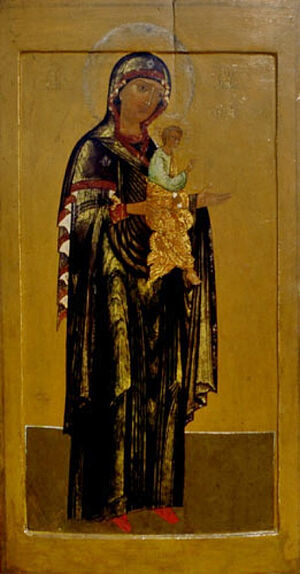 The miracle-working Kosino (Modena) Icon of the Mother of God “Here you g-go again! Another ch-church… They’d better build a b-beer house,” a young drunkard who was unsteady on his feet hiccupped and nodded his head towards the Holy Lake and the Church in honor of the Icon of the Mother of God, the “Life-Giving Spring” under restoration at the lakeside. He expected our approval. But, seeing my brother’s steely gaze, he got confused and walked away, staggering.
The miracle-working Kosino (Modena) Icon of the Mother of God “Here you g-go again! Another ch-church… They’d better build a b-beer house,” a young drunkard who was unsteady on his feet hiccupped and nodded his head towards the Holy Lake and the Church in honor of the Icon of the Mother of God, the “Life-Giving Spring” under restoration at the lakeside. He expected our approval. But, seeing my brother’s steely gaze, he got confused and walked away, staggering.
I was about to throw up my hands theatrically over the lake waters and begin to lament our lost spirituality in my well-trained voice, but my brother cut me short quickly:
“Come on! This is the local Grishka Kuterma from the Legend of the Invisible City of Kitezh. God willing, he will come to his senses, grow wiser and repent. Hurry up! The church warden is waiting for us in the church.”
The church warden Taisia Viktorovna Starostina was waiting for us on a bench outside the church. We arrived in Kosino—a former ancient village near Moscow, now a district in the east of the capital—in the midst of summer. My brother had read that the original wonder-working Kosino (Modena) Icon of the Mother of God is kept at the Dormition Church in Kosino. The church stands on the shore of the White Lake; and there are three lakes in Kosino: the Black Lake, the White Lake, and the Holy Lake.
“...It was on this lake that an icon of St. Nicholas appeared, and the first church in Kosino was built in honor of this saint...”
“The Holy Lake is very pure and perfectly circular,” Taisia Viktorovna related. “The Battle of Kulikovo warriors and pilgrims who went to the Holy Lake from all over Moscow were cured by its healing waters, rich in silver and iodine. Many scientists believe that the Holy Lake was formed due to a collapse of the ground, which only confirms the legend about the hermit Vukol.”
Church bells have rung on the shores of the Kosino lakes throughout the great history of the long-suffering city of Moscow. In 1717, Emperor Peter I, for whom frigates of his “fleet for amusement” had once been built on the White Lake shores, donated to the Dormition Church a great relic—the icon of the Mother of God brought by Count Boris Petrovich Sheremetev from the Italian city of Modena. It was famous for many miracles and healings.
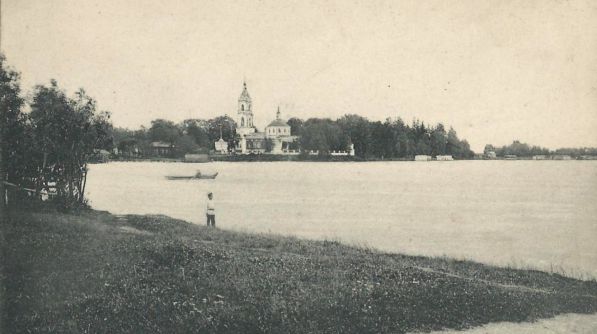 The White Lake in Kosino, 1900-1910
The White Lake in Kosino, 1900-1910
On passing through the church gate, we entered the kingdom of roses. Satin-scarlet and pearly white, with dewdrops on their moist fragrant petals, the roses swayed in the breeze in the memory of the Garden of Eden. And in front of us, surrounded by flower beds and emerald trees, like an island of Heaven on earth, towered three churches: two stone ones—the grand Dormition Church and the magnificent St. Nicholas Church with a candle-like bell tower, and the wooden St. Tikhon’s Church.
“Taisia Viktorovna, it’s hard to believe our eyes: we saw photographs of this holy place in the Soviet era. There was desolation: some workshop for the manufacture of kerosene lamps, a warehouse for theatrical props, doghouses... How long did it take to restore all this?” I wondered.
“The damage by the godless authorities was terrible6. In 1939, they tore down the crosses from the Kosino churches, brought some huge vats to the churchyard and cleaned off the gold from the icons in them and threw the icons into a shed or burned them on the shores of the White Lake. The chapel on the Holy Lake was destroyed. In 1940, all services were prohibited, and the churches were closed. It was then that our miraculous Kosino (Modena) and St. Nicholas icons disappeared...”
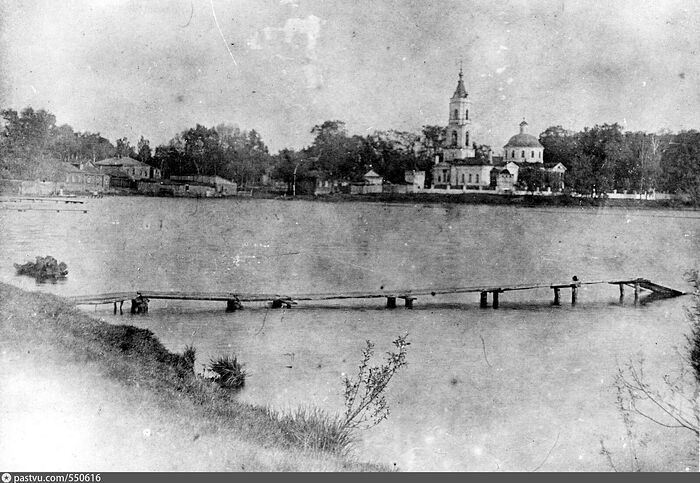 Kosino. The White lake. A view of the church, 1930-1939
Kosino. The White lake. A view of the church, 1930-1939
In 1947, the wooden church of St. Nicholas, built during the reign of Tsar Alexei Mikhailovich (1645-1676), was burned down, and in 1950 the godless barbarians destroyed the iconostasis and broke the walls in the Holy Dormition Church, hoping to find treasures there. The silent Kosino churches—without crosses, icons and frescoes, with rusty water flowing down the leaky walls—stood in the wind like mutilated martyrs for Christ...
“...But the Most Holy Theotokos, Who chose this place and gave it Her miraculous icon as a blessing and a visible sign of Her protection, did not allow this place to be completely destroyed.”
Just as in the early nineteenth century, after the expulsion of the Napoleonic army, through the efforts of the God-loving merchant and honorary citizen of Moscow Dimitri Alexandrovich Lukhmanov7 the Kosino churches and villages devastated by the “enlightened French” were restored, in the late twentieth century the Lord blessed the revival of the house of His Most Pure Mother and She performed a great miracle by returning Her icon (which seemed to have been lost forever) to the Kosino parish.
Soon after the Great Patriotic War, the legendary curator of the collections of the Andrei Rublev Ancient Russian Art Museum Vadim Vasilyevich Kirichenko, having arrived on business at the Leningrad Museum of the History of Religion and Atheism, saw there an icon of the Mother of God that struck him. On the reverse of the icon the unusual inscription, “Of Modena”, attracted his attention. He managed to take the icon to Moscow and put it in the storerooms of the Ancient Russian Art Museum on the territory of the former Andronikov Monastery of the Savior.
Years later, rumors about the supposedly found relic reached Kosino. In the late 1970s, old-timers of Kosino, Maria Alexeevna Ivanova and her sister, heard from Dmitry Dmitrievich Gushchin from the regional Department of Culture about the mysterious icon with the inscription, “Of Modena”, kept in the Andrei Rublev Museum.
Both women perfectly remembered what the lost miraculous Kosino (Modena) Icon looked like. Arriving at the museum, they asked to see the icon. Vadim Kirichenko, who still worked at the museum, reverently carried the icon out and the Kosino parishioners recognized it.
The history of the next fifteen years is an amazingly providential story of the revival of the Kosino churches and their preparation for the return of the great relic.
Soon after the significant discovery of the icon of the Mother of God, the Moscow authorities in some inexplicable way decided to restore the Kosino churches.
“By the way, it was in 1977—a very atheistic year,” my brother remarked thoughtfully. “Of course, it was a miracle of God.”
Over the course of ten years, the stone Holy Dormition and St. Nicholas Churches were renovated, a new wooden church was built on the site of the burned one (later consecrated in honor of Patriarch Tikhon), and classical music concerts began in the Holy Dormition Church.
In 1990, St. Nicholas Church was returned to the Russian Orthodox Church, and His Holiness Patriarch Alexei II appointed Archpriest Michael Farkovets its rector. Many of his faithful parishioners from the Church of the Dormition of the Most Holy Theotokos in Veshnyaki followed him to Kosino. Among them was Taisia Viktorovna Starostina, who since 1990 has been the permanent church warden of the parish.
“I converted to the faith at a mature age,” Taisia Viktorovna related. “It was thanks to my father-confessor who had prayed for me for three years. In 1985, I turned in my Communist Party membership card... And our Kosino churches were restored through Father Michael’s labors and by everyone together. Everything was based on obedience, everything was done with the priest’s blessing. But it was not easy: there was no end of work. I lived in St. Nicholas Church’s basement, and Father Michael—in the caretaker’s house. On November 16, 1990, St. Nicholas Church was consecrated, and the first Liturgy was celebrated. On the same day, the Renewal of the Church of Great-Martyr George in Lydda is celebrated. George the Victorious was buried in this church after his martyrdom, and pilgrims flocked there for many centuries. And in the nineteenth century, after the people’s faith had faded, the church fell into disrepair and turned into ruins. Russian knights of the Order of St. George and Emperor Alexander II sent money, and the church was restored, and on November 16 (according to the new calendar), 1872, it was consecrated. So on this day, November 16, in two parts of the world—here in Moscow and in Lydda (now the Israeli town of Lod)—the renewal of two Orthodox churches is commemorated!”
In 1991, its main shrine, the Kosino (Modena) Icon of the Mother of God, returned to Kosino.
“Father Michael reported to His Holiness Patriarch Alexei II that the miraculous icon was in the Andrei Rublev Museum,” Taisia Viktorovna recalled. “His Holiness turned to the then Minister of Culture Nikolai Nikolayevich Gubenko (may his memory be eternal!), and he immediately decided to return the icon to the church. What a great event it was! On July 2, 1991, we all arrived at the territory of the former Andronikov Monastery. After the blessing ceremony the director of the museum handed over the miraculous icon, decorated with flowers, to Bishop Arseny of Istra, Vicar Bishop of the Moscow Diocese. The sun was shining. What nationwide joy it was! We took the icon across Moscow in a motorcade: cars stopped, and it seemed that the whole city was praying. Then we carried the icon in our arms while singing in a solemn procession. The next day, July 3, when the Kosino (Modena) Icon is commemorated, His Holiness Patriarch Alexei II arrived and celebrated the Liturgy at St. Nicholas Church. This was followed by a procession of the cross to the Holy Lake, where a prayer service to the Most Holy Theotokos was held.”
In April next year the Mayor of Moscow Yury Luzhkov signed the decree on the transfer “within a month” to the Russian Orthodox Church of two other churches of the Kosino complex—the old Holy Dormition Church and the newly rebuilt wooden one.
“On receiving the decree, Father Michael8 burst out crying,” Taisia Viktorovna continued. “What a happy day it was... On April 23, 1992, the Holy Dormition Church was consecrated, and on July 2 of the same year, the miraculous Modena Icon of the Mother of God was solemnly translated there from St. Nicholas Church. So our great relic returned to the Holy Dormition Church.”
Several years ago, after venerating the miraculous icon a pilgrim knelt down and began kissing the steps of the Holy Dormition Church. Thus he thanked the Most Holy Theotokos Who had delivered his family from many years of childlessness and granted his wife and him a long-awaited son.
There are countless stories of miraculous healings and help from the Kosino (Modena) Icon of the Mother of God recorded since the late eighteenth century alone. And how many of them have occurred in the last thirty years since the return of the miraculous icon to Kosino! Inexplicable from a “normal” point of view, miraculous cases of the Mother of God’s help, revealed through Her icon, shatter ossified everyday “common sense” and strengthen our faith.
In 2000, Maria Semyonovna from the Sumy region, who was being treated for a serious oncological disease at the Filatov Hospital in Moscow, prayed and wept at the icon. According to the doctors’ prognosis, she had about a month to live. Having learned from her daughter about the miraculous icon, Maria Semyonovna who was very religious went to Kosino. The church was closed, and the woman, unaware that the workers opened it at the request of pilgrims, left in order to return the next day. But the next day the church was closed again...
Only on the third day (!) was the dying woman finally able to venerate the miraculous Kosino Icon and pray for a long time in tears... The next day an X-ray showed that her tumor had shrunk. Three days later, on a second examination the doctors were convinced that the tumor had become even smaller, and when they did the third X-ray, they saw that the tumor... had disappeared! After that the Filatov Hospital specialists decided that the apparatus had been out of order and carried out seventeen more X-rays: the tumor had disappeared. The doctor in charge was shocked and, after a pause, looked at Maria Semyonovna and threw up his hands:
“There is nothing to say here. Apparently, the ‘universe’ heard you.”
In 2001, the venerated icon of Hieromartyr Athenogenes of Sebaste with his ten disciples (+ c. 311; feast: July 16/29) was returned to the Holy Dormition Church9. Before his martyrdom, this saint asked the Lord for the forgiveness of the sins of all who would turn to him and his disciples in prayer.
“All pilgrims pray in front of this icon,” Taisia Viktorovna said. “The Lord is merciful: maybe someday our miracle-working icon of St. Nicholas will return as well—the one that was found on the Holy Lake10.”
Stars are beginning to gleam over the Holy Lake. Lights are flickering in the dark, like candles in an invisible church. The tolling of bells is floating over the God-protected city. God is alive—my soul is alive too.

